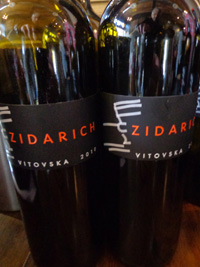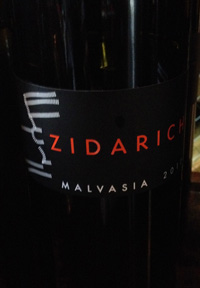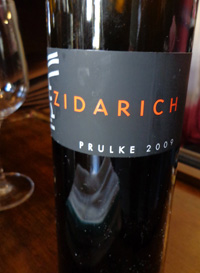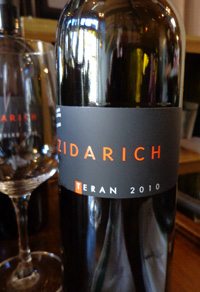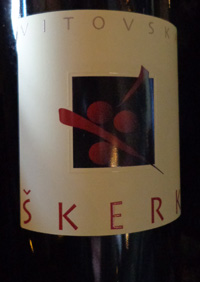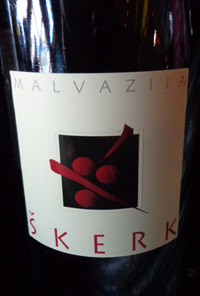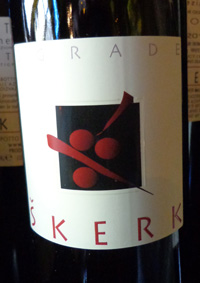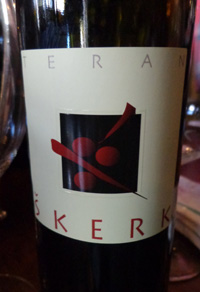Special Updated Report on “Orange Wine” from the classics of Carso, Italy to some new California versions that are well worth chasing down!
by Kerry Winslow, grapelive.com
A decade ago two of Italy’s star winemakers that not many have heard of visited San Francisco to show off their latest releases, mainly “orange wines” and chat about their historic region, the Carso in the Friuli-Venezia Giulia, and I was there to soak it all in. This area, Carso, which lies in Italy’s far Northeast close to the Slovenian border, in fact some of the vineyards actually straddle both sides, and is one the world’s hot spot for skin contact white wines or what we call orange wines. Benjamin Zidarich and Sandi Skerk, both hugely respected for their wines, are continuing a long tradition of organic farming and winemaking with a proud love of their land and region. This area has many historical influences and has ancient traditions and customs, one of which is “Orange” wine, this is white wine usually that sees long contact with the skins, that gives “Orange” wine it’s name. Most white wine the world over is made from just the juice of the grapes with little or no contact with the grape skins, though there are some adventurous winemakers trying out this ancient style of winemaking in California, Germany, Spain and Australia, though it is much more popular in Eastern Italy, Slovenia, Croatia and in the Caucasus mountains, in places like the Republic of Georgia. The “Orange” wines are left on the skins, this is called maceration, and the amount of time on the skins varies depending on each wineries house style, some as little as 10 to 15 days and with some like Skerk that sees up to 40 days. The result of this long maceration is a more complex, and usually savory flavors more like red wines coming through, the wines tend to be tangy, spicy and exceptionally dry in character. While some wineries use Amphora to age “Orange” wine, neither Skerk or Zidarich employ ceramic vessels, they both use wood fermenters and age in cask or stainless, which might explain why both Skerk and Zidarich present such clean, fresh and elegant wines. My prior “Orange” experience has been mixed, and while I find skin contact white wines interesting and worth the exploration, there have been many disappointments, and some “Orange” wines can be oxidized, sherry like and volatile with dirty/muddy flavors, not so with Zidarich and Skerk, these are pretty and focused wines with elegance and vibrancy. Other serious and seriously good wines come from Gravner, older versions from Kante and of couse Radikon, maybe the most sought after “Orange Wine” that along with Skerk and Zidarich produce unique and complex world class wines. Both Shkerk and Zidarich are alluring and seductive wines, here are a few of my favorites, and I highly recommend checking these wines out, Viva la Orange!
The Carso Old World “Orange Wines” of Zidarich and Skerk
Zidarich, Vitovska, Friuli-Venezia Giulia, Italy.
Made from the native Vitovska grape, the wine shows bright grapefruit, melon and spiced pear, a light yellow hue and savory elements, this comes across austere and seriously dry, but it grows on you with time in the glass. The is an array of flavors that pop up, unexpectedly like cured meat, cheesy notes and there is a zest burst of acidity that adds kick to this white from Italy’s remote Northeast. A classic seafood white that is dusty dry and tangy fresh the Vitovska is a unique expression of grape, region and winemaking. Orange rind, lemon oil, verbena and soy notes come through after time in the glass.
($45 Est.) 87 Points, grapelive
Zidarich, Malvasia, Friuli-Venezia Giulia, Italy.
This Malvasia is golden/yellow with intense savory meaty layers, bright acidity, chalky minerals and tension filled dry fruits, dried apricot, pear, yellow canned peach, bacon oil, apple skin and orange rind. This vigorous white has loads of character and interesting elements, but needs time to come together. This Malvasia should potentially prove to be a seductive gem, though it is tight, powerful and somewhat severe at this stage. As an orange wine, the spice and savory side dominate and I’m certain with the right cuisine I’d come around to appreciate this well made white much more. The 2011 was much more interesting than the 2010 version, and Benjamin Zidarich explained 2010 was a tough and frightful vintage, while the 2011 looks set to be a classic in the region, though I noticed his wines seemed to need more time and thought to be as pleasing on the palate as I would like, give some time, I’ll be intrigued to re-visit this vintage in a few years.
($45 Est.) 90 Points, grapelive
Zidarich, Prulke, Friuli-Venezia Giulia, Italy.
This intriguing white is made up of 60% Sauvignon Blanc, 20% Malvasia and 20% Vitovska, Zidarich’s Orange wine cuvee sees a long maceration, fermenting on the skins for at least 14 days, and this is the darkest hued wine in the stable, though not orange in color, but more golden and sunny in appearance. Benjamin Zidarich loves his Sauvignon Blanc vines and uses them to good effect here, but he says he’d never even consider not using it as part of a cuvee, keeping with ancient tradition to blend, and he feels it would take away from the sense of place he feels very proud of, he says a Sauvignon Blanc only wine would be more French that the Carso area. Regardless this wine is gorgeous and complex with lemon/lime, melon, peach, saline/iodyne notes, tangerine and kumquat. This was my favorite Zidarich wine and while generous on the palate it is brisk, spicy and finishes on the dry savory side, with perfect acidity and focus throughout.
($45 Est.) 94 Points, grapelive
Zidarich, Teran, Friuli-Venezia Giulia, Italy.
The red from Zidarich is lively, vivid and tangy with sour plums, wild cherry, blackberry and peppery spices, Teran or Terrano is a native grape related to Refosco and found in Croatia as well. I was able to taste 3 different Teran wines together, which all showed regional similarities and style, very unlike Refosco from just a few miles closer to Vence or to Teran found in Croatia, this is very much a wine of it’s place. The tangy notes are like sucking on a sour candy, very puckering and mouth watering, but still the fresh fruitiness shines through. The color is opaque and dark, the nose is spicy and the palate is zesty filled with acidity and spice, while a hint of floral incense adds flair to this medium light red. This wine grew on me in the glass and the lingering boysenberry note was compelling, though I had hoped for a touch more depth.
($42 Est.) 88 Points, grapelive
Skerk, Vitavska, Friuli-Venezia Giulia, Italy.
Sandi Skerk’s Vitovska is a lovely and brisk white, even if technically an “Orange” wine, it shows just a hint of pale yellow and flows vibrantly in the glass, I’d certainly enjoy this wine with oysters! The delicate aromas and sizzling acidity keeps this bright, tangy and fresh throughout, though it gains depth and density with air, best not to serve too cold, cellar temp is best and makes a huge difference. As this wine unfolds it really comes alive with savory elements, mineral and richer fruit notes with tangerine, melon and lemon zest. The Vitavska grape is found only here and is a purely unique example of region, terroir and winemaking, the long maceration on the skins doesn’t bring much orange/pink color, but certainly the skins impart character, spice and tannins making for a gripping wine. Very interesting, though not as pleasing as the Malvasia or the Ograde in the collection from Skerk, both of which are more graceful than the Vitavska alone anyway.
($35 Est.) 88 Points, grapelive
Skerk, Malvazija (Malvasia Istriana) Friuli-Venezia Giulia, Italy.
Sandi Skerk’s Malvazija is stunningly fresh and beautiful with impressive depth, elegance and life, for an orange wine it is delicate, vivid and crisp, not what I was expecting, but was gifted with a happy surprise, this really is glorious and complex wine. With such long maceration, up to 40 days on the skins, I thought the color was not much different than a normal chardonnay in the glass and this vibrant and tangy Malvasia shows vigor and intensity without losing any charm or grace. The nose is clear with steely mineral tones, jasmine, citrus oil and orange pulp leading to a zesty palate of lemon/lime, tangerine, peach and marmalade with chalky dry spices, stones and bitter almond. This a profound white wine that showcases a region and style that needs to be taken much more seriously.
($40 Est.) 94 Points, grapelive
Skerk, Ograde, Friuli-Venezia Giulia, Italy.
A proprietary white blend of Vitavska, Pinot Grigio, Sauvignon Blanc and Malvasia is real Orange wine that shines pink/orange in the glass and tastes fresh and lively, the Skerk hallmark, this is lovely and compelling wine. This cloudy and dense dry wine feels light on it’s feet with bright and zesty aromas and flavors with tangerine, citrus flowers, savory and salty spices, mountain herbs, apple skin, peach and persimmon. I had been expecting a tawny element, but none showed up, this is pure, vivid and fresh wine that makes you re-think your ideas of “Orange” wines, this is an ancient style of winemaking known from Italy to the Republic of Georgia, and the Skerk version is stable, tangy, clean and delicious. The color is from the Pinot Gigio which has pink/grey skins, the long maceration bleeds the orange/pink hue, Sandi Skerk claims between 15 and 40 days on the skins with this wine, though he adds that long skin contact doesn’t always mean more color in the Orange wine, he says some wines with only 10 or 14 days sometimes have a much darker color from the skins. This is totally drinkable and beautifully balanced wine that begs for food, cured meats, cheeses, seafood and almost anything that requires a dry wine would be super with this dynamic wine.
($40 Est.) 94 Points, grapelive
Skerk, Terlan, Friuli-Venezia Giulia, Italy.
Slightly less dark than the Zidarich Teran I tried alongside and more structured than the Skerk 2010, the future release coming from Skerk the 2011 Teran is a tangy combination of sweet and sour flavors, spice and is a fine example of this grape and regional style with a slightly more elegant frame and more defined fruit. I would happily drink this wine almost anytime and enjoyed the play between the candied and sour mixed berry fruits and plum core. There is a pepper jelly and cracked pepper play too that is interesting as well to go with added elements of meat, mineral and kirsch notes that fold into the blackberry and bramble that comes through mid palate in this fun and vibrant wine. As mentioned the Teran grape is also known as Terrano in Italy and is off-shoot of the more well known Refosco varietal found in near by areas. Skerk, well respected for his “Orange” wines, certainly makes a good red too, drink young and enjoy the zesty freshness of this unique wine from the hills of Carso.
($35 Est.) 91 Points, grapelive
A couple of other classic “Orange Wines” from Friuli-Venezia Giulia
2007 Gravner, Bianco Breg, Venezia Giulia, Italy.
The wines of Josko Gravner are legendary and some of the most intriguing wines in Italy, coming from the borderlands of Venezia Giulia where the vineyards sweep into Slovenia, and where the wines seem to dip into then ancient past, this is the home of the modern Italian Orange wine. These long aging skin contact wines, sometimes considered or called hipster juice, are unique expressions of an ancient craft, very natural and savory in flavor, they can be either gloriously textured and beguiling, or the they can be bizarre or seriously flawed with funky/stinky volatile. The Gravner wines are beautifully made and seriously lovely, now fermented in Amphora exclusively on the skins, his Amphorae come from Georgia and are the big beeswax lined vessels that are sunk into the earth, Josko was one of the first modern area winemakers to employ them in the region. The Gravner estate extends about 60% into Slovenia, this allowed him to more easily travel to Georgia back in Soviet times to investigate the use of Amphora, it wasn’t easy to get these big clay/terracota vessels to Italy safely, in fact it was a decade of trying and heartbreak before a enough of them could be used to make the wines he envisioned. Gravner’s wines take 7 years from harvest to market at least, white or red, he believes this is the perfect amount of time, and I tasted the current releases of the 2007 whites and two of the reds, a 2001 Merlot, non amphora and 2004 Pignolo, again non amphora, as the reds made in amphorae didn’t get going until 2006. The reds were stunningly pure, elegant and freshly detailed, impressive and very eye opening, since I have mainly only heard of the more famous Orange white wines from Gravner! The 2007 Bianco Berg was drinking beautifully open and aromatic, it was my favorite of the orange/whites on the day, just a bit more expressive than the fine Ribolla, it showed a wonderful depth of detail and dry richness that made it excellent with food, it shouldn’t be served too cold either, more like a red wine, it’s golden/peachy hue shines in the glass, it is a blend of varietals including Riesling, Sauvignon Blanc, Pinot Grigio and Chardonnay that come from terraced plots of the estate and are fermented separately, each picked when ripe, Gravner picks later and this wine is 14.5% which I believe adds to the pleasure and seductive character, fermentation in amphora on the skins and malos, then aged a further six years in old casks before bottling. The 2007 is still bright, vital and non oxidized with an array of citrus, stone fruits and topical fruit with a balance between savory and fruity elements with earthy tones, chalk and mineral as well as jasmine, lime and dried apricot. These wines were presented to us by Mateja Gravner, Josko’s daughter, who wowed us with the history of Gravner, the region which still is haunted by the two World Wars, and her passion was infectious and made the experience that much more meaningful, these are wines that expand the senses and are worthy of exploration. Gravner has just joined Rosenthal (importer) and should be more available on the US market in January, be sure to look out for them!
($89 Est.) 93 Points, grapelive
2012 Damijan Podversic, Ribolla Gialla, Friuli, Italy.
One of the most seductive whites in Italy is Damijan’s Ribolla Gialla, and this 2012 is showing wonderful beauty, life and detail, it was one of my top picks at the recent Slow wine show in San Francisco, it’s an orange wine yes, but not hipster funky at, it is gorgeous in feel, stylish, elegant, seamlessly layers and vibrant throughout. The skin contact with Ribolla leaves a radiant golden hue and the tangy/savory element act like soft tannins helping to balance and structure the wine, and this Damijan is one of the best I’ve tasted with a palate of tangerine, crisp golden apple, hints of apricot, lemon/lime and yellow peach fruits along with bright mineral tones, bitter herb, jasmine tea and wet stones. The texture is lovely and while there is a endless play of extremely subtle sweet and sour, it’s depth of satiny layers seduces completely. This wine, like the wines from Gravner, Foradori and COS, are what makes giddy about ancient method skin contact whites, they are not severe or funky, they are easy and joyous to drink on their own and are wonderful with cuisine. Damijan’s other two blended wines show a bit more density and edginess, making them very interesting, but maybe slightly less pretty and delicate when compared to this vibrant Ribolla Gialla. This mysterious corner of northeast Italy is ripe for a major breakthrough and begs for discovery, Damijan, an all organic estate in Friuli, is one of must try wines from the region, this 2012 Ribolla Gialla is drinking proof of the potential, it’s full of terroir and quality, drink over the next 3 to 5 years.
($45 Est.) 94 Points, grapelive
New California Orange Wines
2021 Extradimensional Wine Co. Yeah!, Close Encounters, Skin Fermented Orange Wine, Brosseau Vineyard, Chalone AVA, Monterey County.
California “Orange Wines” have come of age and found a small and enthusiastic niche, with some versions really reaching new heights of quality and balance, one of those is this brilliant Close Encounters Brosseau Vineyard skin fermented organic blend of 40% Chenin Blanc, 40% Chardonnay, 8% Viognier, 6% Roussanne and 6% Marsanne from the chalky soils of Chalone in the Gabilan Mountains Ranch by Hardy Wallace of Sonoma’s excitingly unique Extradimensional Wine Co. Yeah! Winery. This wine glows rose gold pinkish in the glass and has plenty of stony and light floral aromas that leads to a slightly phenolic and exotic palate of dried pineapple, earthy muskmelon, apricot, preserved lemon, quince and apple fruits, along with oyster shell, crystalized ginger, brown butter, saline infused wet rock, verbena, sea shore and honeysuckle. The textural quality, zesty acidity and fine tannins make this Close Encounters very intriguing and reminds me of some of my favorite Italian versions from the Friuli-Venezia Giulia, which lies in Italy’s far Northeast close to the Slovenian border, like the wines made by Benjamin Zidarich and Sandi Skerk. That said, Wallace has made this Close Encounters very much his own, especially with the choice of grapes used, which give a bit more fruit density and a tropical note. Some of the hipster Orange Wine offerings can be kombucha funky, or ultra savory, this one doesn’t go there, but obviously it won’t excite the mainstream wine drinker, though it makes no apology about that either. I highly recommend checking out the Extradimensional Wine Co. Yeah! wines and following Hardy on social media, he has a larger than life personality and charm that shines through in his wines.
Winemaker Hardy Wallace macerated these grapes on the skins with classic foot trodding and native yeast fermentation, allowing good flavor extraction and some grip, with a lengthy skin contact, measured in weeks, not hours and matured it in neutral barrels for a few months. The Brosseau Vineyard, in Monterey’s Chalone appellation is farmed all organic and is set on a complex mix of the region’s famous limestone, as well as some decomposed granite, and some volcanic material, it’s an area that always delivers a terroir influence, even in a wine such as this one. The 2021 Close Encounters, which I first tasted with Hardy at his Extradimensional Wine Co. Yeah! tasting room in downtown Sonoma, just off the historic square, is a dry and intense wine that will appeal to a wider audience than you’d think and not as funky as you’d expect, it makes for a nice companion with, as Hardy suggests, Paella and or Jambalaya dishes. The wine finished at 13% natural alcohol and perfectly captured the ripe elements of grapes, while also retaining good tart and fresh acidity, hitting a nice sweet spot. Hardy says the flavors of the 2021 Close Encounters are incredibly playful on top of a canvas of serious substance, which is what I found too. Going on he adds that this wine is where wilderness meets a fantasy metropolis. Explaining the name, Wallace notes that this orange wine is written in a beautiful, yet unknown language that was made to communicate with extraterrestrial life. I don’t always gravitate to “Orange Wine” but there’s a few exceptions that really impress me and this is a really fun example that would be one of my go to California versions. I admit to being a fan of this winery, especially the latest set of reds, with their outstanding old vine Carignane, Mourvédre, Hardy’s favorite grape, and Grenache offerings really hitting the spot for me.
($55 Est.) 93 Points, grapelive
2023 I. Brand & Family Winery, Supertoothy, Skin Fermented White Wine, Central Coast.
I got a leak preview of a new and rare skin contact white wine from winemaker Ian Brand, which is going to released in July of 2024, that is mostly Sauvignon Gris, a grape you don’t see much of in California, as well as small amounts of Verdelho, a grape Ian has now added to his line of La Marea label, along with Pinot Gris and Chenin Blanc. This bright yellow gold Supertoothy is not as deeply hued or edgy as many “Orange” wines are, it shows off a crisp, bone dry and light to medium bodied palate of kumquat, pear, tangy peach, apple, earthy Cavaillon melon and quince fruits, which are accented by a saline sea shore intensity, plus loamy wet stone, bitter herbs, iodine and tart lemon rind. Brisk and austere by natural, Ian Brand’s Supertoothy, which sports a label designed by his son, will first be available to the I. Brand & Family wine club, with any bottles left over with be mainly sold directly at their tasting room in the Carmel Valley Village. Coming from vineyards that Ian works with on the central coast, all of which are sustainably farmed and rocky soiled sites, this exciting wine, also delivers a cool climate personality and Pacific Ocean influenced inner energy. Ian has told me many times that the Monterey region is maybe most exciting for white varietals and he’s really made it a challenge to argue with him, especially when you try his Arneis, Albariño, Chenin Blanc and Sauvignon Blanc, in particular his most recent vintages!
The debut of the I. Brand & Family Winery “Supertoothy” blend, is made from 68% Sauvignon Gris, 24% Verdelho, 4% Pinot Gris and 4% Chenin Blanc, and is based around a small block of the rare Sauvignon Gris grape on Vista Verde Vineyard in San Benito County. Sauvignon Gris, mostly found around the Bordeaux region, is a lightly pink mutation of Sauvignon Blanc that typically has smaller berries, high acid and a spicy profile which in this wine, as Ian Brand notes, showcases the calcareous soils of Vista Verde beautifully. Brand held the must of the Sauvignon Gris on skins for five days before pressing and fermented with endemic yeasts in stainless steel before aging the Supertoothy in neutral barrels for about 6 months. After which he blended it with the Portuguese white Verdelho, along with tiny splashes of Pinot Gris (that also saw skin contact) and racy Chenin Blanc for a wine that Brand calls zippy, special and decidedly delectable. This salty fresh, mineral driven and slightly phenolic skin fermented white came in at a nicely ripe, but vibrant 12.67% natural alcohol, making it a totally uniquely California wine, of which just 222 cases were made. This tasty 2023 Supertoothy, to best show its charms, should be enjoyed with food, and due to its less fruity character, so subtle cuisine choice work well, in particular goat cheese and or fresh raw oysters. These latest releases from the I. Brand & Family Winery, La Marea and Paysan labels are delicious, very interesting and value packed stuff, so I recommend checking them all out.
($28 Est.) 92 Points, grapelive
*This is a partial re-post of an original article I did back in 2013 with a little update and the California wines were tasted recently.

